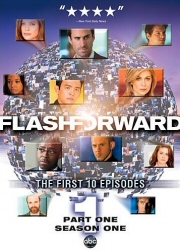Season One, Part One
- Drama
- 2009
- Buy the DVD
All photos © ABC
Reviewed by Will Harris
()
s soon as it was announced that the sixth season of “Lost” would be its last, the powers that be at ABC immediately began scrambling to find that magical series that could potentially take on the heavy-pressure title of “the new ‘Lost.’” Heavy is the head of the series forced to wear that particular crown, but it certainly seemed like “FlashForward” had the potential to fulfill such an awesome destiny. The Robert J. Sawyer novel which inspired the series had an extremely interesting premise: an experiment involving the Large Hadron Collider accelerator results in everyone on the planet losing consciousness for about two minutes, during which time they receive a glimpse of the future. It’s arguable that more than a few things were lost in the translation, but we’ll get to that in a moment.
Given that this so-called FlashForward event occurred worldwide, there’s no end to the number of stories which can be told, but the series chooses to focus predominantly on an interconnected group of individuals in Los Angeles. It only stands to reason that a governmental agency would be interested in investigating an event as profound as this one, and the center of attention here is the FBI. Special Agents Mark Benford (Joseph Fiennes), Demetri Noh (John Cho), and Janis Hawk (Christine Woods) quickly find themselves knee-deep in the case, along with their supervisor, FBI Assistant Director Stanford Wedeck (Courtney B. Vance), but the proceedings branch out much further once the series begins to delve into their personal lives. It only stands to reason: since everyone’s seen their future, everyone’s got a stake in finding out if it’s really going to come to pass – or indeed, if it can be changed.
In Benford’s case, his visions revolve around his attempts to solve the mysteries of the FlashForward event, but his wife Olivia (Sonia Walger), a surgeon at a Los Angeles hospital, sees herself in her house, talking rather intimately with a man she’s never met before. Given that she’s had no history of infidelity, she’s horrified by this, and you can imagine that her husband’s none too thrilled about it, either. The situation isn’t helped any by the fact that Olivia soon finds herself treating a young autistic boy whose father turns out to be the man from her vision: Lloyd Simcoe (Jack Davenport). Benford’s partner, Special Agent Noh, has problems of his own: he didn’t have a vision, which leads him to believe that he’ll be dead in six months time, a theory that wreaks havoc on his relationship with his fiancée, Zoe (Gabrielle Union). As for Special Agent Hawk, her vision finds her having a sonogram, which is particularly interesting, given that she isn’t even pregnant yet.
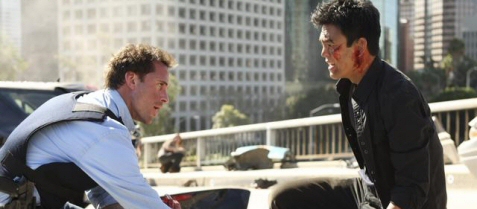
If these plotlines don’t interest you, don’t worry: there are plenty of other characters and storylines spiraling in and out of “FlashForward.” Special Agent Benford is a recovering alcoholic, and his sponsor, Aaron Stark (Brían F. O'Byrne), has had a vision of his supposedly-deceased daughter, alive and well. Surgical intern Dr. Bryce Varley (Zachary Knighton), who works with Olivia, was literally moments away from committing suicide when the FlashForward took place, giving him a vision of a future which inspired him to go on. And who’s this strange fellow who looks suspiciously like Charlie from “Lost”? Well, obviously, it’s Dominic Monaghan, but revealing anything more about his character within this review would spoil far too much for those who haven’t yet checked out the series.
As far as those aforementioned differences between the book and the show, granted, the fact that Sawyer’s novel is less than 400 pages long and offered a definitive ending automatically meant that there’d have to be a certain amount of tweaking to make it work as a weekly series. The first decision was to shrink the visions of the future from 20 years to a mere six months, thereby creating more of a sense of immediacy to whether or not the visions will come true; the second was to make it more of a mystery about the origins of this time-jump, thereby keeping those who’ve already read the book guessing. Was it really the Large Hardon Collider accelerator that made this happen? It takes several episodes before this explanation is even thrown into the mix, and even then, we’re left with considerable uncertainty about whether or not the series is truly going to follow this route.
But while “FlashForward” is certainly an intriguing series, there’s a heck of a lot going on, and the amount of forward motion with some of the storylines will often leave you wanting. There’s also a tendency to spend as much of the episodes playing catch-up as there is moving forward, which can be frustrating with so many unanswered questions floating around out there. One can only hope that, when the series returns in March, the producers will have remedied some of these issues; within these 10 episodes, there’s enough going on that you’ll probably be among the viewers who’ll be tuning in to find out if they have.
Special Features: Maybe they’re saving the commentaries for the complete Season One set, but for now, all fans are getting is a behind-the-scenes featurette (“Creating Catastrophe: The Effects of a Global Blackout”) and two brief looks into what we can expect when the show returns (“‘FlashForward’: A Look Ahead” and the oddly-titled “Could”).
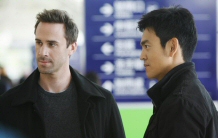 |
 |
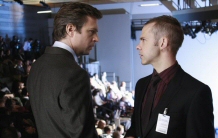 |
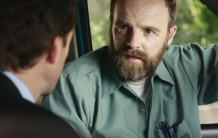 |
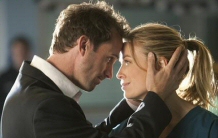 |
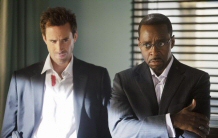 |
You can follow us on Twitter and Facebook for content updates. Also, sign up for our email list for weekly updates and check us out on Google+ as well.













